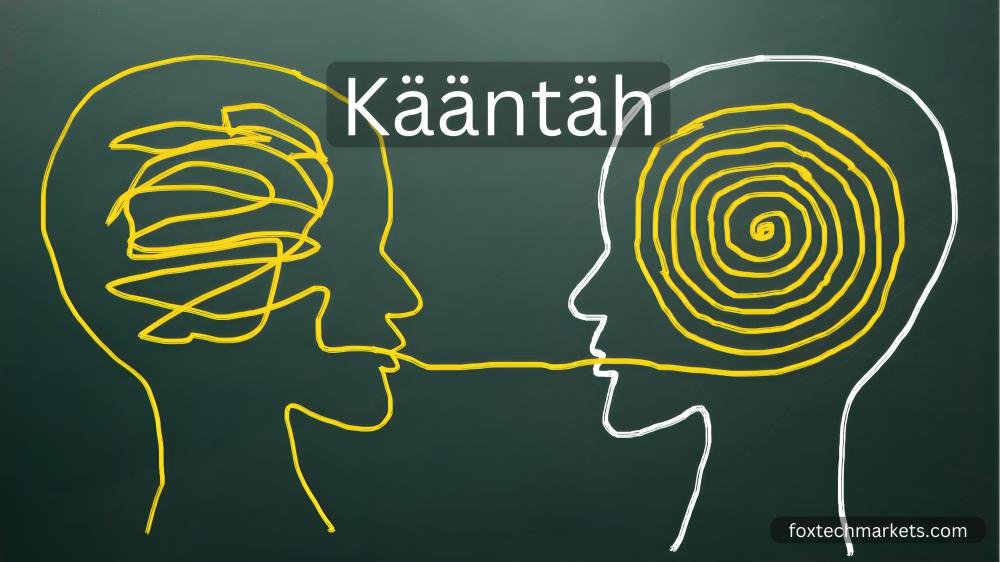Introduction to Kääntäh
It is rather interesting to study the term “Kääntäh” as this term encompasses cultural, linguistic, and historical elements. Rather than just a work dedicated to translations, It seems to provide more complex view on the language and communication.
This article tries to explain the details of ‘Kääntäh’ focusing the history aspect and relation to the modern society. Translating and Interpreting studies will also briefly address the area’s relevance in different areas such as translation, intercultural communication, technology, among others.
Kääntäh in the Light of Etymology and Genesis
The literal name of the brand “Kääntäh” has a complex history related to the Finnish language. From the verb kääntää, it offers the true feel of the word, meaning ‘turn’ or ‘translate. ’ The origin of “Kääntäh” could be said to be historic as old developments of the Finnish language where the word was used to mean the action of turning as well as the act of translation.
To the ancients, suffix and root did not only refer to the word “Kääntäh” but to what surrounded it as a concept implying change from one state or realm to another. This could mean literally turning over a new page or could be the changing of ideas from one language to the other. The history of the term indicates the appreciation of the Finnish people regarding language as a means for comprehending and explaining the existing reality.
Cultural Importance and Rituals
As taken from the earlier part, “Kääntäh” is very prominent in the Finnish culture. Yes, it is more than a mere linguistic term and it is a link that is bridges cultures and ideas in particular. The profession of translating, or “kääntäh,” is honorable, and carries the implication that it is a task that demands an especially strong degree of comprehension of the source and the target languages. This respect includes cultural differences, idioms, and other features that are critically important for getting the proper translation.
Essentials of culture in Finland: Kääntäh is a fundamental element of Finnish folklore; Kääntäh is present in the tales and narratives that tell a story since the ancient time by translating it to the contemporary Finnish language. Such rituals emphasize how it is critical to respect the cultures that are worth preserving and translate their relevant materials correctly.
Also, there are festivals and educational environments, dedicated to “Kääntäh” and the art of translation in which it is used. Such events highlight translation as more than a way to keep cultural identity and ensure mutual understanding between cultures.
Bounded Concepts of ’’Kääntäh’’
Hence, ‘Kääntäh’ is not easily translatable into English because the word has more meanings than just the general interpretation. Transformation is the major concept that it conveys; it refers to change, adaptation or the process of metamorphosis. Here, “Kääntäh” does not only entail change of word from one language to another but also combining the words with socio-cultural aspects implicit in those words.
Due to the fact that “Kääntäh” is a word that has many different meanings this seems very versatile in terms of usage. In literature, this may refer to taking a story and condoning it to other cultures for instance changing the setting of the story. This in the area of technology maybe interpreted to mean adaptation of software to suit the needs of users in different parts of the world.
In addition, “Kääntäh “can be translated back into ‘change’ and ‘growth’ pointing to the process in the person. Similarly to how translators change texts so that they can be appreciated by new users, people can ‘kääntäh’ their lives and accept new views and opportunities.
Regional and Linguistic Variations
Depending on the area and language environment, the definition of “Kääntäh” is rather ambiguous. Sometimes, it might concentrate on the translation of texts and their wording, in other cases, it might accentuate the meanings of texts and their cultures.
For instance, in areas where the oral tradition is developed, “Kääntäh” can be the ability to translate spoken folklore into writing but at the same time, retaining the main idea and cultural value of a story. Conversely, towards the urban developed society they may only be referring to technical interpretation or localization of the content in today’s technology.
Yet, the essence is concerned as well; the variations of the literal meaning of the term “Kääntäh” can be traced in multiple features of the Finnish language and the translation process being heavily reliant on the cognitives of the source and target languages. This, therefore, underlines the need to employ professional and competent translators especially in the light of these variations in translating the same phrases.
“Kääntäh” in Modern Communication
Specifically, in today’s world of information technology and advanced communication, “Kääntäh” has acquired new meanings in the contemporary process of communication. Due to globalization and the tremendous increase use of internet in the society, the demand for the best translation services has been prompted. Since then, “Kääntäh” involves in such typology as translating websites and software for localization, and helping people to communicate with the foreigners through the social networks.
They are one of the peculiarities of the contemporary discussion that is to convey the meaning comprehensively and remain faithful to cultural difference at the same time. It is here, that “Kääntäh” comes into the picture. Translation can often count on words, as it is the application of cultural and communication competence that can avoid misinterpretation and disrespect towards the recipient.
In the realm of “Kääntäh” technological development will also play the role as with Machine translation and AI models of language translation which have transformed the field of translation and made it faster and feasible. However, those tools also suggest that there is still a great demand for the professional translators being able to attend to the nuances that the machines fail to.
Symbolism and Metaphorical Significance
The term “Kääntäh” as used by the Firqa of Saba and Hayla is packed with symbolism or is metaphorical in every sense of the word. At the same, it stands for change and evolution. In the same way as a translator rewrites a text to fit into a new context, “Kääntäh” might represent metamorphosis, personal and cultural.
The significance of “Kääntäh” can be yet another semiotic aspect of characters’ development or search, in literature. It participated to the intent of the work mainly because it emphasised the concept of translation beyond words, but beyond the strength and message of the story.
The name symbolically corresponds to the cultural meaning of sharing and transferring thoughts and ideas as well as narrowing the gap within two different culturally distinct groups. It symbolises the constant process of becoming and the development that results from a contact with other people and cultures.
Idioms and Expressions
“Kääntäh” is a very important term that seems to be very much integrated in many of the proverbs and phrasal expressions of the Finns and indeed others. Such phrases are widely used and typically convey the meaning of translation and adaptation in the most eloquent and fitting manner.
For instance, the Finnish idiom “kääntää takkinsa” which has a literal translation as ‘to turn a coat” presupposes the meaning connected to the concept of transformation expressed in the term “Kääntäh. “The meaning of the Finnish idiom “kääntää lehden” can be translated into English as “turn over a new leaf” and it is connected to the meaning of change and new start.
Kääntäh is described in these idioms as the essential tool for translating content while taking all the details of language into consideration. They show that translation is somewhat more than the transformation of one language into equivalent one but the recognition of what meanings make words meaningful.
Cross-Cultural Communication
The word “Kääntäh” has the key role to play in easing the communication in between two different cultures. In a world that is slowly tackling towards the globalization factors, interpreters are needed to interpret the various languages used and culture in the society.
Cross cultural communication goes beyond just conversion and thus workers need to have cultural intelligence. It is at this point that “Kääntäh” comes in handy. As such, “Kääntäh” goes beyond direct translation of words and ideas but cultural essences, which fosters togetherness and understanding among different groups of people.
In business, politics and personal communications, one cannot lack for “Kääntäh” to ensure the message is passed in the right manner. It allows people with different experiences to be able to easily communicate with one another, exchange information and possibly work on various projects that seek to foster togetherness in the society.
Modern Localization Services
The services of localizations have rapidly developed in the recent past and “Kääntäh” is in the middle of these developments. It is not confined to conversion of content for a different language but connotes cultural transposition to create an appealing offer for consumers of a given culture.
Today, localization is a very comprehensive scope of activities, including web-site and software translation, as well as marketing and multimedia content adaptation, etc. These services ensure that by avoiding wrong translation that may make content to mean what it actually has not been intended, it becomes easy for the targeted audiences to understand and relate to the content.
Localization is an inherent part of translating, which aims at considering the differences in languages as well as cultural peculiarities in order to determine how the particular audience would prefer to receive the information. This makes “Kääntäh” a valuable asset among professionals in the field as they strive to produce relevant information that brings change and transform the lives of different groups of people.
Modern Applications of Kääntäh
Thus, “Kääntäh” has quite many uses in the modern world across the various fields. In technology it is used essential for software and applications and websites localization to satisfy the international users. This is not solely about the translation of words, but also adapting such aspects as interfaces, graphics and more to the cultural and language preference of different regions.
But most important in the media and entertainment industry, Kääntäh is the core activity to translate movies, dramatic shows, and books for overseas markets. This helps to make practical the content so that that people from different cultures can also gain enjoyment out of it.
In education, “Kääntäh” is used to render textbooks, instructional materials and online courses for distributing education for learners all over the world. This in turn assists in increasing the world’s embracing of knowledge exchange and working together.
Creative Expressions
As such, creative interpretations are also enclosed by the term “Kääntäh” which implies not only the literal translation but also the renewal of the already read and thought texts and ideas. In literature, this can be translated to mean an ability to translate a poetic or prose piece so that while the idea speaks to the literary class, its utilization of aesthetics and emotions appeals to a different generation.
In the arts, the term “Kääntäh” also covers the translation of visual or performing art pieces into a different culture/background. This can be on altering elements of a play or artwork so as to make it more relatable to the different audiences of the society.
Posting help or information on the internet and having an active presence on the different social media platforms.
Another word relevant in the era of social networking and other online platforms is “kääntäh”. Similar to the offline use that was originally specific to Finland and fulfilling its role as a Finnish word, the history of its use on the Internet also reflects the history of the Internet.
Social media platforms exist as an active platform of interaction with the users and ‘Kääntäh’ through the creation of different types of content; Hashtags, memes and user generated post. As such, these interactions increase its cultural relevance as people start discussions online or find camaraderie with individuals who are keen on Finnish language and culture.
Leveraging Digital Platforms
It is worth mentioning that Instagram, Twitter, and Facebook act as enablers in the process of disseminating “kääntäh” and its various interpretations because discussions related to the phenomenon can be searched through the hashtags #kääntäh and #FinnishLanguage.
Social media posts and viral content include posts various jokes and comments on the usage of the term “kääntäh” in digital contexts. Further, social groups interested in language itself and in culture also contribute to the globalization of the “kääntäh” by gathering people from all over the world who care about linguistic discovery.
Engaging Global Audiences
It also focus on its local culture but has iterated on a global appreciation for what it means to be a “kääntäh” Ultimately. Based on their findings about “kääntäh,” language learners, translators, and cultural researchers avail themselves of online platforms to analyze the cultural meaning behind the language expression. Internet groups and forums make sharing information and experience possible, enhance the view of the Finns and their culture around the world.
Impact on Cultural Identity
The analysis of the current digital media presence of the term “kääntäh” proves how it contributes to the modern Finnish culture. Whether, or to what extent, it should be used and what its meanings should be are subjects of changing opinions and heated conversations online, signaling the merging of the old and the new in the process of this linguistic phenomenon’s development.
While technology advances and forms of communication change, ‘kääntäh’ gives hope in language relations and communication, thus symbolising language relations in cyberspace.
Controversies Surrounding “Kääntäh”
Although regarded as one of the main cultural symbols of Latgale, “kääntäh” has not escaped controversies and discussions about appropriation and commodification. Such issues primarily can be attributed to misconceptions or distortion of its cultural background and meaning. Some critics suggest that the commercialisation of the term “kääntäh” degrades inherent value which the term carries as the linguistic asset of Finnish people.
Appropriation vs. Appreciation
The disputes of ‘’kääntäh’’ are located in the space of questions about what is ethical for using and sharing cultural markers and motifs. Regarding cultural connotations, the original meaning and associations of “kääntäh” must be respected as right when translating it into foreign languages, people’s reactions all around the world, and its application as a pop-culture phenomenon should be comprehensibly justified.
Commercialization Dilemma
Thus, the character of “kääntäh” with appealing to the business intent is quite often used in the commercial addresses, but the given organizations do not always differentiate it from the indigenous characteristics of local culture. Goods to which “kääntäh” is attached may portray stereotypical or misunderstanding about the identity of the wearer and in a way profit off the `Finnish culture’.
This commercialization presents problems for the continued cultural significative of “kääntäh”, consequently raising debates regarding the need to be sensitive to this marketing process.
Community Perspectives
The debates of introducing the term “kääntäh” and other related controversies are influenced and exist within a Finnish and an international context. Cultural integrity’s advocates demand that its representatives work toward preserving it and raising people’s awareness about it.
The message is also an open invitation to cultural institutions, distinguished linguists, and North Sámi leaders to engage responsibly with “kääntäh” and converse about the portrayal of culture collectively.
Educational Interpretations
Thus, in the context of education “kääntäh” is useful in understanding both Finnish language and culture. Education is enriched by it its integration into curricula as it benefits language development among students and cultural awareness among teachers and learners.
Educational considerations of the word “kääntäh” aim at providing cultural, historical, and social meanings of the word, which would help to diversify the academic discussion and contribute to the exploration of Finnish traditions.
Academic Curricula
Finnish universities include “kääntäh” in courses on language and culture to support students’ learning process of linguistic peculiarities of the country. Through pair and group work language exercises and cultural workshops related to “kääntäh,” students are able to engage the language and meaning behind it in an active context In this way, students are exposed to the historical, social and hedonic uses of the word within literary texts and media relevant to today’s society in Finland.
Cultural Competence
Learning of kääntäh helps the learners to develop a cultural awareness in line with the intended social purpose for learning a foreign language in the global world. Educational interpretations highlight the connection between language and culture: curriculum also promotes students’ reflection on social consequences of language and language usage.
In the course of cross-cultural studies and carried out affiliative endeavors, teachers create culturally diverse classrooms that embrace multiculturalism and multilingualism.
Lifelong Learning
In addition to education, “kääntäh” fosters in people the desire to learn and engage in enriching activities in their lifetime. Random people, interested in the language and/or culture of Finland spend their time in independent learning processes and word-of mouth communication.
In addition to this, one can search for information on the internet through the digital archives and virtual libraries and get to interconnect and share with the global community on the interpretations of “kääntäh”.
Future Trends and Predictions
As for the future of “kääntäh,” it can be assumed that the ensemble will also continue to develop and transform with base in global trends and new technologies. Expected future includes its impact on the digital interactions, in the cultural heritage initiative, and in the learning process.
In the growing multifaceted culture of interconnection and fusion of cultural frameworks, “kääntäh” is well positioned to contribute positively to the exchange of ideas, and better the general global comprehension across cultural and linguistic barriers.
Digital Integration
Therefore, the digital environment is a rich opportunity that implies the potential for the concept of “kääntäh” to be interpreted and developed further. New developments in translation technologies and digital localization services increase its availability to audiences in different parts of the world in carrying out cross cultural and content distribution functions.
It is due to social networks that various translation options for the term “kääntäh” are discussed and coined by the international community of linguists and people engaged in information exchange online.
Cultural Preservation
The continuation of the attempts to preserve and continue usage of “kääntäh” as the element of the culture indicate its importance for Finns. Cultural institutions as well as linguistic specialists and community members work to preserve its purity and pass it on to the next generations.
Outcomes major on the recording of oral narratives, literatures’ preservation as well as preserving languages towards the ongoing processes aimed at ensuring that the term “kääntäh” remains active in the cultural periphery.
Educational Innovation
New strategies of education and knowledge-sharing include “kääntäh” as a part of complex academic curricula that focus on multilingualism and cultural heterogeneity. Schools and universities use objects and technologies connected to information and communication and educational experiences to cultivate the learning of Finnish language and culture.
Through encouraging curiosity and critical thinking, which are profoundly effective in the development of the learner, the suggested initiatives will help the learners face and work through the problems at the global level and engage in the intercultural communication processes.
Conclusion
Thus, “kääntäh” goes beyond the dictionary to represent the Finnish culture and history in the most meaningful manner. Analyzing the meaning of “kääntäh” and its translation from old Savonian up to the Modern Finnish and other interpretations, it is possible to conclude about the flexibility of the language today as a part of the globalized world.
We as defenders of cultural heritage and promoters of multilingualism rejoice at the fact that there is so much love for “kääntäh” in the contemporary society helping revolutionize the discourse. If only it could embrace the complexity of its ads, and if only it could embrace the complexity of its ads, if only it could embrace the complexity of its ads.
FAQs:
Find answers to your most common questions below, covering everything you need to know about our services, policies, and more.
Q1: In what manner is the term “kääntäh” employed in the current society of Finland?
Currently, “kääntäh” word is familiar and commonly used in everyday spoken language, cultural proverbs, jokes, and even social networks in nowadays Finland.
Q2: The given term is ‘’kääntäh’’’, so let’s discuss various forms of the word in different regions.
This means that, differences in the use of “kääntäh” are a result of different dialects that are present in the different regions that use Finnish as their language.
Q3: In what way does a knowledge of the term “kääntäh” aid effective cross/cross- cultural communication?
Its direct translation is “Kääntäh” and its function is to bridge cultural differences and to provide detailed descriptions of the translated text including cultural references to the global readership.
Q4: What are the trends that can be expected for “kääntäh” in the communicative digital near future?
Based on the given concepts, the future trends for “kääntäh” would be the continuance of its growth in, digital localization, social media, and marketing content creation.
Q5: Although “kääntäh” seems to be used in a more formal linguistic context, can it be determined that it is specifically linguistic?
Although kääntäh is a function of linguistics it goes beyond a linguistic definition to embrace more of culture/symbolic signs.
Q6: How can one further research about “kääntäh” other than the information found in Finnish resources?
From available online resources, over cultural centers, and language courses, one can learn more about “kääntäh” and its presence on an international level.
Q7: It is still important to also understand what misconceptions people may have when it comes to “kääntäh. ”
Misconceptions are its usage only within the Finns and that it has only a minimal use beyond the Finnish speaking population.
Q8: There is a more detailed comparison between ‘kääntäh’ and similar term in other languages.
The comparative analysis with references to other languages singles out specific language characteristics and cultural differences that separate “kääntäh” from the counterparts.
Q9: It is crucial to determine how ‘kääntäh’ became a part of the Finnish culture and what exactly does it represent to conclude the importance of ‘kääntäh’ for the identity of the Finnish people.
This is the reason why “Kääntäh” is a vivid represtative of Finnish culture as it saves the language and brings youth closer to elderly people.






